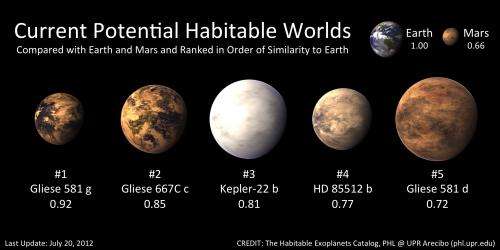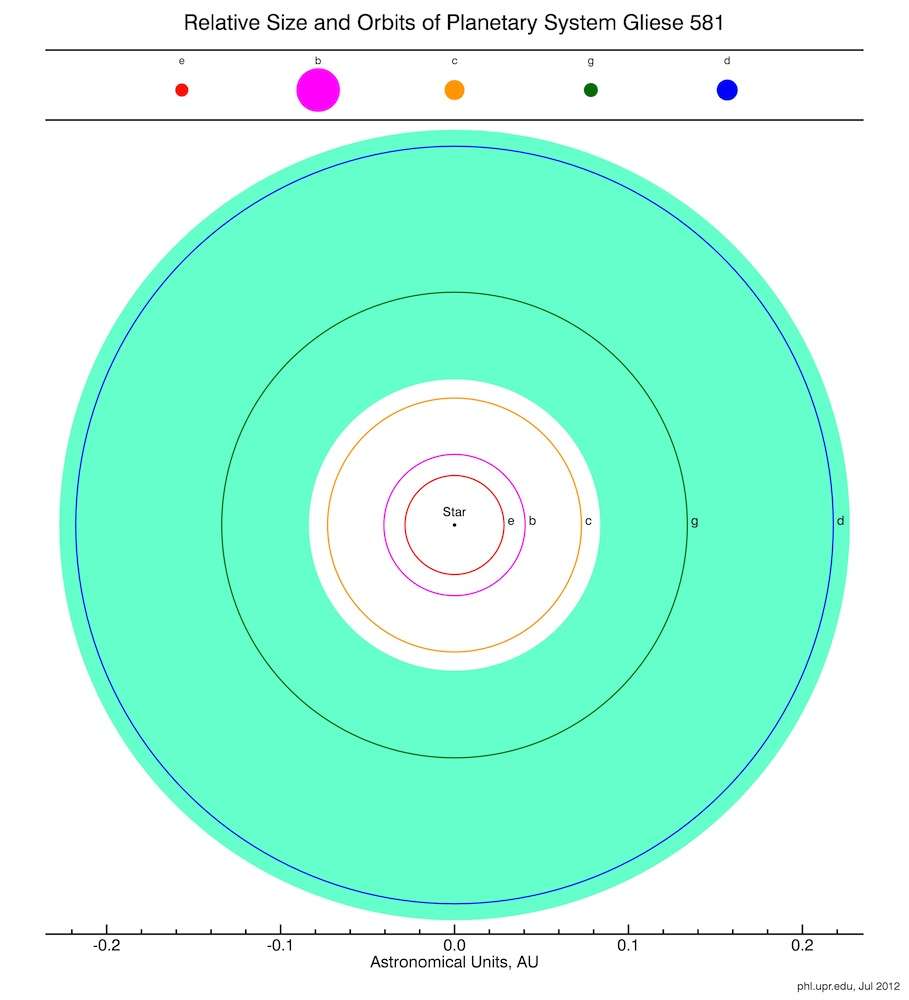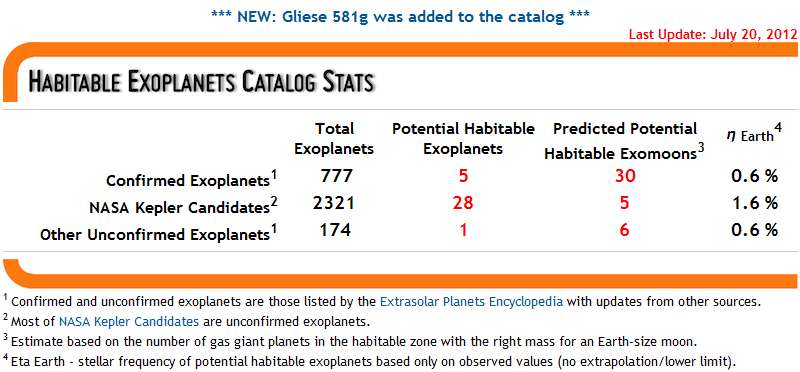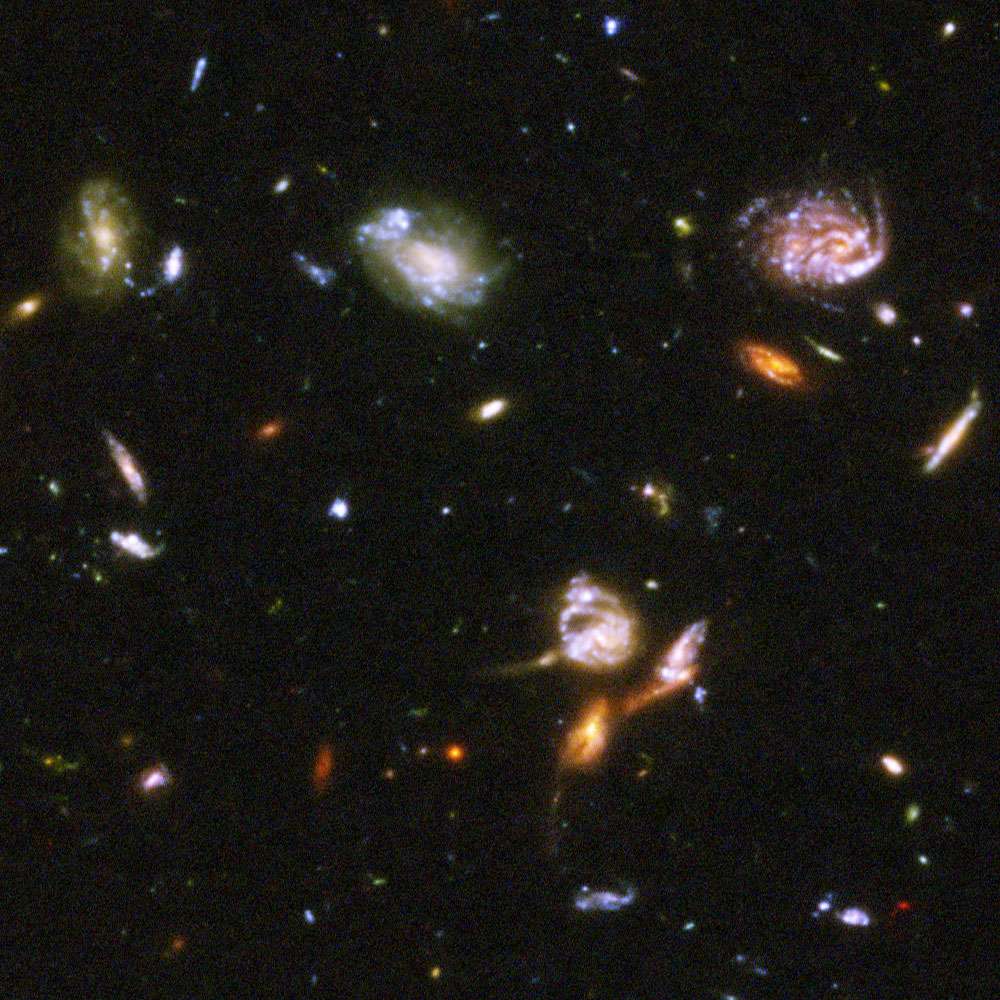It looks like you're using an Ad Blocker.
Please white-list or disable AboveTopSecret.com in your ad-blocking tool.
Thank you.
Some features of ATS will be disabled while you continue to use an ad-blocker.
5
share:
New data suggest the confirmation of the exoplanet Gliese 581g and the best candidate so far of a potential habitable exoplanet. The nearby star Gliese 581 is well known for having four planets with the outermost planet, Gliese 581d, already suspected habitable. This will be the first time evidence for any two potential habitable exoplanets orbiting the same star. Gliese 581g will be included, together with Gliese 667Cc, Kepler-22b, HD85512, and Gliese 581d, in the Habitable Exoplanets Catalog of the PHL @ UPR Arecibo as the best five objects of interest for Earth-like exoplanets.

With a similarity index of 0.92, Gliese 581g is very similar to Earth. More than ever, there's now a real possibility that this exoplanet harbour life.
Moreover, there are now two exoplanet around Gliese ("g" and "d") that are in the habitable zone.
Steven S. Vogt of UC Santa Cruz, present a new analysis with an extended dataset from the HARPS instrument that shows more promising evidence for its existence. The new analysis strength their original assumption that all the planets around Gliese 581 are in circular and not elliptical orbits as currently believed.
Gliese 581g receives about the same light flux as Earth does from the Sun due to its closer orbital position around its host star.
It also probably has a radius not larger than 1.5 times Earth radii.
These factors combine to make Gliese 581g the most Earth-like planet known with an Earth Similarity Index, a measure of Earth-likeness from zero to one, of 0.92 and higher than the previously top candidate Gliese 667Cc, discovered last year.

Comparison of the estimated relative size and orbits of the five exoplanets around Gliese 581. The green shade represent the size of the habitable zone, or the orbital region where an Earth-size planet could have surface liquid water. Planets e, b, and c are too hot for liquid water and life but g and d are in the habitable zone. Planet g is specially in the right spot for Earth-like conditions while d is marginally within these limits, and colder. This is the first case of a stellar system with two potential habitable exoplanets orbiting the same star.
Source: Arxiv
The Habitable Exoplanets Catalog

edit on 21-7-2012 by elevenaugust because: resizing the Gliese star system picture
per request!
edit on 21-7-2012 by elevenaugust because: (no reason given)
Haven't they known about the Gliese 581 system for a while or did they just discover a new smaller planet in it(581g)?
edit on 21-7-2012 by
RSF77 because: (no reason given)
it will be a quick year if living there
"The new planet designated Gliese 581g has a mass three to four times that of Earth and orbits its star in just under 37 days. Its mass indicates that it is probably a rocky planet with a definite surface and enough gravity to hold on to an atmosphere'
www.nasa.gov...
not really very similar to Earth with a mass 3 or 4 times more than earth. I wonder what gravity would be like there
"The new planet designated Gliese 581g has a mass three to four times that of Earth and orbits its star in just under 37 days. Its mass indicates that it is probably a rocky planet with a definite surface and enough gravity to hold on to an atmosphere'
www.nasa.gov...
not really very similar to Earth with a mass 3 or 4 times more than earth. I wonder what gravity would be like there
edit on 21-7-2012 by
ZeussusZ because: (no reason given)
Originally posted by RSF77
Haven't they known about the Gliese 581 system for a while or did they just discover a new smaller planet in it?
Some of these links aren't working for me.
No, they now the whole system for a while, but new data confirm that Gliese 581g is really similar to Earth, more than previously thought.
As a rough comparison, we could say that Gliese 581g is similar to Earth and that Gliese 581d is similar to Mars.
Man, I wouldn't be surprised if we find human artifacts there from a long ago expedition from our technological past. Or a thriving colony. I just
think that its POSSIBLE, that maybe travel between these planets could have already happened. I bet there's some pyramids there at the very least...
reply to post by elevenaugust
Awesome, that's pretty good news especially considering the relatively short distance away it is and now that I read about it... it's only 2.5 times the mass of Earth. Is that doable you think for human life? Or would we only be able to survive in around a constant 1g?
Well... lets go there and find out I guess, better to spend resources on that than killing each other.
Awesome, that's pretty good news especially considering the relatively short distance away it is and now that I read about it... it's only 2.5 times the mass of Earth. Is that doable you think for human life? Or would we only be able to survive in around a constant 1g?
Well... lets go there and find out I guess, better to spend resources on that than killing each other.
edit on 21-7-2012 by RSF77 because: (no
reason given)
Originally posted by RSF77
reply to post by elevenaugust
Awesome, that's pretty good news especially considering the relatively short distance away it is and now that I read about it... it's only 2.5 times the mass of Earth. Is that doable you think for human life? Or would we only be able to survive in around a constant 1g?
Well, that's a good question and I really don't know. My hope now is that they will use their new toys like "Project 1640" for example which is capable to directly see the exoplanets or another new technique using ESO's Very Large Telescope, for example, which is able to detect atmospheric changes between the planet's morning and evening, the amount of carbon monoxide present, etc...
reply to post by elevenaugust
Good stuff, it would be nice to see a picture of an exoplanet in my lifetime.
Good stuff, it would be nice to see a picture of an exoplanet in my lifetime.
reply to post by elevenaugust
Thats just silly. If you were really intent on searching for life within the frame
of our current mess, your would be able to simplify your searches by
dialing in exopheric metallic reflection.
This : www.dailyrecord.co.uk...
It is right there in plain English for all to see.
In other words, look for planets with lots of shiny litter floating around the edges of their atmosphere,
or within shall we say near planetary orbit. As known in our neck of the woods as LEO
Low Earth Orbit, blah, blah,blah.
Bingo!
S&F to your thread
Thats just silly. If you were really intent on searching for life within the frame
of our current mess, your would be able to simplify your searches by
dialing in exopheric metallic reflection.
This : www.dailyrecord.co.uk...
It is right there in plain English for all to see.
In other words, look for planets with lots of shiny litter floating around the edges of their atmosphere,
or within shall we say near planetary orbit. As known in our neck of the woods as LEO
Low Earth Orbit, blah, blah,blah.
Bingo!
S&F to your thread
edit on 21-7-2012 by Wildmanimal because: content/typo
reply to post by Wildmanimal
They can't actually SEE the planet... It's kind of a LONG way away.
They can, however, detect the planet.
Shiny glitter? Not so much.
They can't actually SEE the planet... It's kind of a LONG way away.
They can, however, detect the planet.
Shiny glitter? Not so much.
Also OP, if you want the images you embed to fit, use the [ ATS ] tags for external Images.
For instance,
[ ats = 627x700 ] http : //img442.imageshack.us/img442/1345/phlgl581small.jpg [/ ats ] resizes it to fit without having to use scroll bars.

So many details are often missed by people who don't use the scroll bars with some images, and if it's a HUUUGE image, people can still click to view it in a new tab, etc, in it's full resolution.
OT. It's amazing that given the size of Mars and it's distance from the sun, we're still looking there for signs of life, and finding evidence of water, and know it still has frozen ice caps. It also has a cycle ever 10 million years or so, where it's axis tilts giving it the needed sunlight to melt those caps. Life may be coming and going on mars over and over, and we're stuck in a dry spell.
Seeing Gliese 581g and knowing it's relative distance from it's star, really makes you wonder - a little too close, or a little far away, it's too hot or too cold.. that one is just right. How can there NOT be life on it. We will never know in our life time. It may be a savannah full of space cows, and tribes of 8 legged herdsmen...
They may be looking back at us, going "Ya know Barry, I rekon that panet, that one there, the one we detect there, No, THERE.. I rekon that just might have life on it.." only to be mocked by the religious controlling state, who put him in a castle and say "Don't you come out till your dead you miscreant! - all hail Xenu and may his DC10 never falter."
I wish I knew we'd know one day. At least the knowing that we'd know would be enough to know, so that I could stop pining to exist longer and longer until we find out how long that piece of string is...
For instance,
[ ats = 627x700 ] http : //img442.imageshack.us/img442/1345/phlgl581small.jpg [/ ats ] resizes it to fit without having to use scroll bars.

So many details are often missed by people who don't use the scroll bars with some images, and if it's a HUUUGE image, people can still click to view it in a new tab, etc, in it's full resolution.
OT. It's amazing that given the size of Mars and it's distance from the sun, we're still looking there for signs of life, and finding evidence of water, and know it still has frozen ice caps. It also has a cycle ever 10 million years or so, where it's axis tilts giving it the needed sunlight to melt those caps. Life may be coming and going on mars over and over, and we're stuck in a dry spell.
Seeing Gliese 581g and knowing it's relative distance from it's star, really makes you wonder - a little too close, or a little far away, it's too hot or too cold.. that one is just right. How can there NOT be life on it. We will never know in our life time. It may be a savannah full of space cows, and tribes of 8 legged herdsmen...
They may be looking back at us, going "Ya know Barry, I rekon that panet, that one there, the one we detect there, No, THERE.. I rekon that just might have life on it.." only to be mocked by the religious controlling state, who put him in a castle and say "Don't you come out till your dead you miscreant! - all hail Xenu and may his DC10 never falter."
I wish I knew we'd know one day. At least the knowing that we'd know would be enough to know, so that I could stop pining to exist longer and longer until we find out how long that piece of string is...
Originally posted by mainidh
I wish I knew we'd know one day. At least the knowing that we'd know would be enough to know, so that I could stop pining to exist longer and longer until we find out how long that piece of string is...
IMO, one thing is for sure is that, given the exponential progress of the signal detection techniques, we will see the discovery of life outside our solar system in the next decade.
It will be the most important discovery of human kind, and we will be lucky enough to be part of it!

edit on 21-7-2012 by elevenaugust because: (no reason
given)
glad it's confirmed..I was sad when I found out it was unconfirmed
I HAVE BEEN WAITING FOR THIS MY WHOLE LIFE! CAME ACROSS THE READ UP ABOUT IT LASTNIGHT AND ITS BEEN ON MY MIND ALL DAY!
Originally posted by mainidh
reply to post by Wildmanimal
They can't actually SEE the planet... It's kind of a LONG way away.
They can, however, detect the planet.
Shiny glitter? Not so much.
I found it on Stellarium. It's there!
Just follow the coordinates.
20 Light Years away.....Stellarium shows the star as HIP 74995
Going to the Libra Constellation puts you in the ballpark.
new topics
-
Electrical tricks for saving money
Education and Media: 1 hours ago -
VP's Secret Service agent brawls with other agents at Andrews
Mainstream News: 2 hours ago -
Sunak spinning the sickness figures
Other Current Events: 3 hours ago -
Nearly 70% Of Americans Want Talks To End War In Ukraine
Political Issues: 3 hours ago -
Late Night with the Devil - a really good unusual modern horror film.
Movies: 5 hours ago -
Cats Used as Live Bait to Train Ferocious Pitbulls in Illegal NYC Dogfighting
Social Issues and Civil Unrest: 6 hours ago -
The Good News According to Jesus - Episode 1
Religion, Faith, And Theology: 8 hours ago -
HORRIBLE !! Russian Soldier Drinking Own Urine To Survive In Battle
World War Three: 10 hours ago
top topics
-
SETI chief says US has no evidence for alien technology. 'And we never have'
Aliens and UFOs: 17 hours ago, 8 flags -
Cats Used as Live Bait to Train Ferocious Pitbulls in Illegal NYC Dogfighting
Social Issues and Civil Unrest: 6 hours ago, 8 flags -
Florida man's trip overseas ends in shock over $143,000 T-Mobile phone bill
Social Issues and Civil Unrest: 13 hours ago, 8 flags -
VP's Secret Service agent brawls with other agents at Andrews
Mainstream News: 2 hours ago, 7 flags -
Former Labour minister Frank Field dies aged 81
People: 15 hours ago, 4 flags -
Bobiverse
Fantasy & Science Fiction: 13 hours ago, 3 flags -
HORRIBLE !! Russian Soldier Drinking Own Urine To Survive In Battle
World War Three: 10 hours ago, 3 flags -
Nearly 70% Of Americans Want Talks To End War In Ukraine
Political Issues: 3 hours ago, 3 flags -
Sunak spinning the sickness figures
Other Current Events: 3 hours ago, 3 flags -
Late Night with the Devil - a really good unusual modern horror film.
Movies: 5 hours ago, 2 flags
active topics
-
VP's Secret Service agent brawls with other agents at Andrews
Mainstream News • 19 • : NoCorruptionAllowed -
VirginOfGrand says hello
Introductions • 5 • : burritocat -
The Reality of the Laser
Military Projects • 44 • : Zaphod58 -
SETI chief says US has no evidence for alien technology. 'And we never have'
Aliens and UFOs • 42 • : Boomer1947 -
NASA Researchers Discover a Parallel Universe That Runs Backwards through Time - Alongside Us
Space Exploration • 71 • : charlyv -
Sunak spinning the sickness figures
Other Current Events • 4 • : annonentity -
Cats Used as Live Bait to Train Ferocious Pitbulls in Illegal NYC Dogfighting
Social Issues and Civil Unrest • 12 • : Hakaiju -
HORRIBLE !! Russian Soldier Drinking Own Urine To Survive In Battle
World War Three • 28 • : budzprime69 -
Huge ancient city found in the Amazon.
Ancient & Lost Civilizations • 61 • : Therealbeverage -
Should Biden Replace Harris With AOC On the 2024 Democrat Ticket?
2024 Elections • 49 • : Therealbeverage
5
